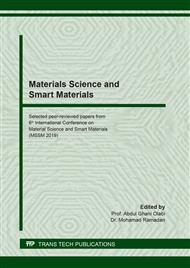[1]
C. Sierra et al , Feasibility Study on the Utilization of Serpentine Residues for Mg(OH) 2 Production,, Waste and Biomass Valorization, vol. 9, no. 10, p.1921–1933, (2018).
DOI: 10.1007/s12649-017-9926-9
Google Scholar
[2]
M. Gupta and W. L. E. Wong, Magnesium-based nanocomposites: Lightweight materials of the future,, Mater. Charact., vol. 105, p.30–46, (2015).
Google Scholar
[3]
F. Cao, G. L. Song, and A. Atrens, Corrosion and passivation of magnesium alloys,, Corros. Sci., vol. 111, p.835–845, (2016).
DOI: 10.1016/j.corsci.2016.05.041
Google Scholar
[4]
S. N. Mathaudhu et al., Magnesium Technology Magnesium Technology,, p.269–273, (2014).
Google Scholar
[5]
M. E. Turan, Y. Sun, Y. Akgul, Y. Turen, and H. Ahlatci, The effect of GNPs on wear and corrosion behaviors of pure magnesium,, J. Alloys Compd., vol. 724, p.14–23, (2017).
DOI: 10.1016/j.jallcom.2017.07.022
Google Scholar
[6]
Q. B. Nguyen and M. Gupta, Increasing significantly the failure strain and work of fracture of solidification processed AZ31B using nano-Al2O3 particulates,, J. Alloys Compd., vol. 459, no. 1–2, p.244–250, (2008).
DOI: 10.1016/j.jallcom.2007.05.038
Google Scholar
[7]
M. E. Alam, S. Han, Q. B. Nguyen, A. M. Salem Hamouda, and M. Gupta, Development of new magnesium based alloys and their nanocomposites,, J. Alloys Compd., vol. 509, no. 34, p.8522–8529, (2011).
DOI: 10.1016/j.jallcom.2011.06.020
Google Scholar
[8]
W. J. Joost and P. E. Krajewski, Towards magnesium alloys for high-volume automotive applications,, Scr. Mater., vol. 128, p.107–112, Feb. (2017).
DOI: 10.1016/j.scriptamat.2016.07.035
Google Scholar
[9]
J. Liu et al., Techno-Economic Analysis of Magnesium Extraction from Seawater via a Catalyzed Organo-Metathetical Process,, Jom, vol. 70, no. 3, p.431–435, (2018).
DOI: 10.1007/s11837-017-2735-6
Google Scholar
[10]
D. Sediako, D. Weiss, and A. Nabawy, Magnesium Technology 2018,, (2018).
Google Scholar
[11]
S. Chuayboon and S. Abanades, Clean magnesium production using concentrated solar heat in a high-temperature cavity-type thermochemical reactor,, J. Clean. Prod., vol. 232, p.784–795, (2019).
DOI: 10.1016/j.jclepro.2019.05.371
Google Scholar
[12]
H. Lu, G. Wu, and N. R. Neelameggham, Aluminum-silicon alloys prepared from high-aluminum fly ash to extract magnesium from serpentine,, Miner. Met. Mater. Ser., vol. Part F6, p.557–564, (2018).
DOI: 10.1007/978-3-319-72362-4_52
Google Scholar
[13]
Z. Liu, G. Lu, and J. Yu, Electrochemical behavior of magnesium ions in chloride melt,, Ionics (Kiel)., vol. 2, p.2719–2727, (2019).
DOI: 10.1007/s11581-019-02881-1
Google Scholar
[14]
M. Kreuh, Behaviour of Magnesium Hydroxylchlorides in Fused Salt Electrolyte,, vol. 2, (2004).
Google Scholar
[15]
C. B. Gills, Nonferrous Extractive Metallurgy. John Wiley & Sons, (1980).
Google Scholar
[16]
Q. Huang, G. Lu, J. Wang, and J. Yu, Thermal decomposition mechanisms of MgCl2·6H2O and MgCl2·H2O,, J. Anal. Appl. Pyrolysis, vol. 91, no. 1, p.159–164, (2011).
DOI: 10.1016/j.jaap.2011.02.005
Google Scholar
[17]
K. Sugimoto, R. E. Dinnebier, and J. C. Hanson, Structures of three dehydration products of bischofite from in situ synchrotron powder diffraction data (MgCl 2 · n H 2 O; n = 1, 2, 4),, Acta Crystallogr. Sect. B Struct. Sci., vol. 63, no. 2, p.235–242, Apr. (2007).
DOI: 10.1107/s0108768107002558
Google Scholar
[18]
Y. L. Wu, X. F. Huang, M. De Yang, S. P. Zou, J. Dang, and H. S. Hu, Study on the mechanisms and kinetics of complex's thermal decomposition getting anhydrous magnesium chloride,, J. Anal. Appl. Pyrolysis, vol. 81, no. 1, p.133–135, (2008).
DOI: 10.1016/j.jaap.2007.05.004
Google Scholar
[19]
S. Kashani-nejad, Oxides in the Dehydration of Magnesium Chloride Hexahydrate,, Met. Mater., no. April, (2005).
Google Scholar
[20]
M. Kreuh, Dehydration and Digestion of Magnola Metallurgie Inc. 'Prills' in a Molten Salt,, McGill University, (2003).
Google Scholar


